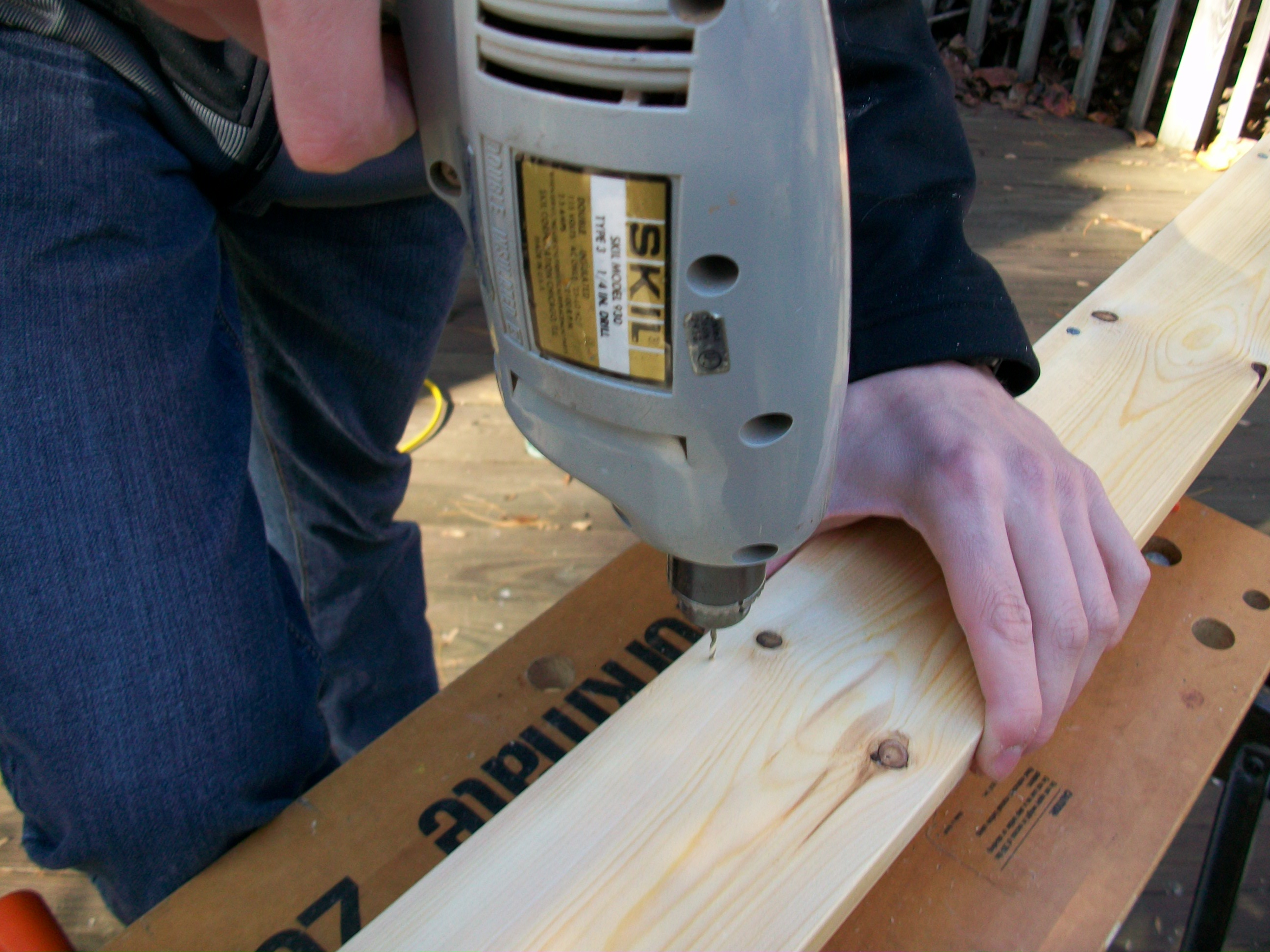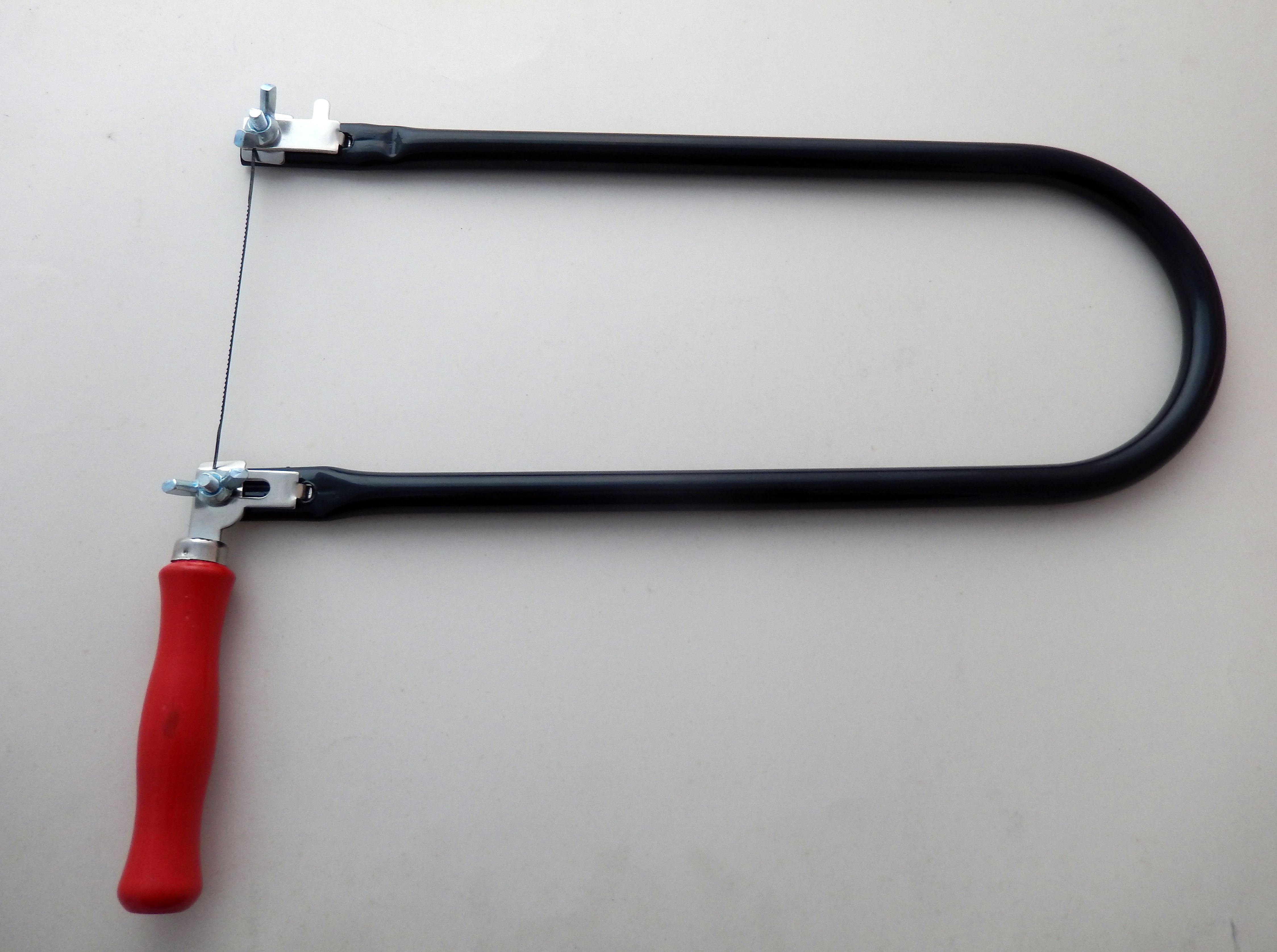|
Compass Saw
A compass saw is a type of saw used for making curved cuts known as compasses, particularly in confined spaces where a larger saw would not fit. Characteristics Compass saws have a narrow, tapered blade usually ending in a sharp point, typically with a tooth pitch of 2.5 to 3 mm (eight to ten teeth per inch), but down to 1.3 mm (up to 20 teeth per inch) for harder materials and as long as 5 mm (as few as five teeth per inch) for softer materials. They have a curved, light "pistol grip" handle, designed for work in confined spaces and overhead. The blade of a compass saw may be fixed or retractable, and blades are typically interchangeable. Partially retracting the blade can prevent flexing and breaking when cutting harder materials. Compass saws are suitable for cutting softer woods, plastic, drywall, and non-ferrous metals. The pointed tip of the blade can be used to penetrate softer materials without the need for a pilot hole. Comparison with other types of saws Compared wit ... [...More Info...] [...Related Items...] OR: [Wikipedia] [Google] [Baidu] |
Compass (architecture)
In carpentry, architecture, and shipbuilding, a compass is a curved circular form. Examples * A compass plane is a plane that is convex, length-ways, on the underside, for smoothing the concave faces of curved woodwork. * A compass saw is a narrow-bladed saw that cuts a curve. * A compass timber is a curved (or crooked) timber, sometimes used in shipbuilding. * A compass brick is a curved brick. * A compass wall is a curved wall. * A compass window is a circular bay window.Sturgis, Russell. "Compass" "Sturgis' illustrated dictionary of architecture and building: an unabridged reprint of the 1901-2 edition". Mineola, N.Y.: Dover, 1989. Print. * A surveyor's compass A circumferentor, or surveyor's compass, is an instrument used in surveying to measure horizontal angles. It was superseded by the theodolite in the early 19th century. A circumferentor consists of a circular brass box containing a magnetic nee ... (or circumferentor) is a measuring instrument used in surveyi ... [...More Info...] [...Related Items...] OR: [Wikipedia] [Google] [Baidu] |
Pistol Grip
On a firearm or other tools, a pistol grip is a distinctly protruded handle underneath the main mechanism, to be held by the user's hand at a more vertical (and thus more ergonomic) angle, similar to the how one would hold a conventional pistol. In firearms, the pistol grip is located behind the trigger and generally held by the hand that operates the trigger. Rifles and shotguns without pistol grips are generally referred to as having "straight" or "upland" (shotguns only) style stocks. Some firearms, starting from a 1840s Belgian carbine,https://littlegun.be/arme%20belge/artisans%20identifies%20l/a%20lesoinne%20et%20pirlot%20gb.htm and most automatic weapons in the 20th century (e. g., Chauchat MG, Thompson submachine gun, AK-47 assault rifle), have a second frontal pistol grip (or foregrip) on the firearm's fore-end to be used by the support hand for better stability in operation. Pistol grips can also serve multiple functions, such as a magazine housing (in ... [...More Info...] [...Related Items...] OR: [Wikipedia] [Google] [Baidu] |
Pilot Hole
In construction, a pilot hole is a small hole drilled into a piece of construction material. Its purpose may be: #to guide a larger drill to the appropriate location and ease the job of the larger drill #allow for the insertion of another hole-making tool, such as a knockout punch, that will produce the final-sized hole, or #locate, guide, and provide clearance for a self-threading screw in wood or plastic to prevent damaging the material or breaking the screw. Pilot for large holes A pilot hole may be drilled the full extent of the final hole, or may only be a portion of the final depth. The pilot drill may be a standard twist drill, another type of drill bit appropriate for the material, or, when the primary purpose is precisely locating a hole, may be made with a short, stiff center drill. The pilot hole also reduces the power needed to turn a large drill bit, and reduces the large bit breakage risk. For twist drill bits, the pilot size is usually selected so that the chi ... [...More Info...] [...Related Items...] OR: [Wikipedia] [Google] [Baidu] |
Coping Saw
A coping saw is a type of bow saw used to cut intricate external shapes and interior cut-outs in woodworking or carpentry. It is widely used to cut moldings to create coped rather than mitre joints. It is occasionally used to create fretwork though it is not able to match a fretsaw in intricacy of cut, particularly in thin materials. Coping saw blades are always thicker and much coarser cutting than typical fretsaw blades and many others of its family members. Coping saws can however cut slight bends in the work, allowing circles to be cut if used carefully. History The coping saw was most likely invented in middle of the 16th century following innovations in metallurgy and with the invention of the spring-driven clock. Blades made of this material were strong and flexible thanks to rolling. This saw was also used in combination with so called ''Chevalet du Marqueterie'', invented in 1780, allowing to saw pack of veneers with one angle of cut. Construction A coping saw ... [...More Info...] [...Related Items...] OR: [Wikipedia] [Google] [Baidu] |
Fretsaw
The fretsaw is a bow saw used for intricate cutting work which often incorporates tight curves. Although the coping saw is often used for similar work, the fretsaw is capable of much tighter radii and more delicate work. It has a distinctive appearance due to the depth of its frame (typically between ), which together with the relatively short blade makes this tool appear somewhat out of proportion compared with most other saws. Compared with the coping saw it has much shallower blades, which are usually extra-fine, up to . This allows much tighter curves to be cut—with many blades even sharp corners are possible—but the blades are also much more fragile compared with that of a coping saw. Unlike the coping saw, the blade has a fixed orientation in relation to the frame. This means that the fretsaw is less useful when cutting long narrow components, but the increased depth of the frame does allow access much further from the edge of the board. The fretsaw is similar in man ... [...More Info...] [...Related Items...] OR: [Wikipedia] [Google] [Baidu] |
Drywall
Drywall (also called plasterboard, dry lining, wallboard, sheet rock, gypsum board, buster board, custard board, and gypsum panel) is a panel made of calcium sulfate dihydrate (gypsum), with or without additives, typically extruded between thick sheets of facer and backer paper, used in the construction of interior walls and ceilings. The plaster is mixed with fiber (typically paper, glass wool, or a combination of these materials); plasticizer, foaming agent; and additives that can reduce mildew, flammability, and water absorption. In the middle of the 20th century, drywall construction became prevalent in North America as a time- and labor-saving alternative to lath and plaster. History The first plasterboard plant in the UK was opened in 1888 in Rochester, Kent. Sackett Board was invented in 1894 by Augustine Sackett and Fred Kane, graduates of Rensselaer Polytechnic Institute. It was made by layering plaster within four plies of wool felt paper. Sheets were thick w ... [...More Info...] [...Related Items...] OR: [Wikipedia] [Google] [Baidu] |
Keyhole Saw
A lock is a mechanical or electronic fastening device that is released by a physical object (such as a key, keycard, fingerprint, RFID card, security token or coin), by supplying secret information (such as a number or letter permutation or password), by a combination thereof, or it may only be able to be opened from one side, such as a door chain. A key is a device that is used to operate a lock (to lock or unlock it). A typical key is a small piece of metal consisting of two parts: the ''bit'' or ''blade'', which slides into the keyway of the lock and distinguishes between different keys, and the ''bow'', which is left protruding so that torque can be applied by the user. In its simplest implementation, a key operates one lock or set of locks that are keyed alike, a lock/key system where each similarly keyed lock requires the same, unique key. The key serves as a security token for access to the locked area; locks are meant to only allow persons having the correct key to open ... [...More Info...] [...Related Items...] OR: [Wikipedia] [Google] [Baidu] |





.jpg)